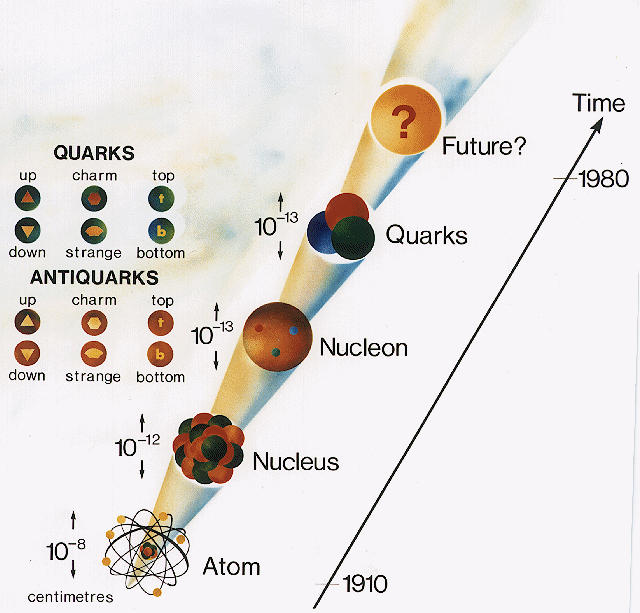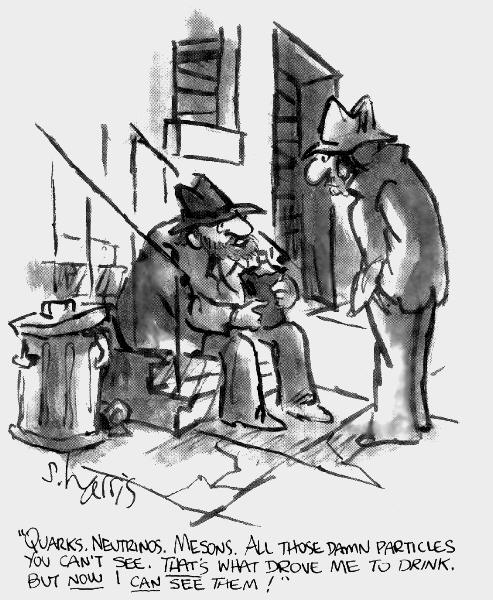Hadrons - Prison for Quarks
 An onion has many layers. A cook who peels off one of these layers gets to the next one
underneath and thus, penetrates ever deeper into the interior of the onion. In a figurative
sense, physicists have peeled off more and more layers in the past in order to understand
the structure of matter. They have worked their way through the atom, the atomic nucleus
and the protons and neutrons in the atomic nucleus down to the quarks. Today, the latter
are regarded as the elementary building blocks of matter together with the electrons. All
the more surprised were the physicists -- and they still are -- when they discovered that
there are no free quarks. They only see particles which consist of several quarks -- the
hadrons. The best-known hadrons are the neutron and the proton. Since they account for
more than 99.9% of the visible matter known to date, hadrons are the mass particles of
our world. For the physicists, they still retain many fundamental mysteries.
An onion has many layers. A cook who peels off one of these layers gets to the next one
underneath and thus, penetrates ever deeper into the interior of the onion. In a figurative
sense, physicists have peeled off more and more layers in the past in order to understand
the structure of matter. They have worked their way through the atom, the atomic nucleus
and the protons and neutrons in the atomic nucleus down to the quarks. Today, the latter
are regarded as the elementary building blocks of matter together with the electrons. All
the more surprised were the physicists -- and they still are -- when they discovered that
there are no free quarks. They only see particles which consist of several quarks -- the
hadrons. The best-known hadrons are the neutron and the proton. Since they account for
more than 99.9% of the visible matter known to date, hadrons are the mass particles of
our world. For the physicists, they still retain many fundamental mysteries.
When the neutron was discovered in 1932, it was clear to the physicists that this, like
the proton, must still be composed of even smaller constituents. Moreover, they found
more and more new particles. Today, more than 200 different particles are known. Many
of them do not even occur in ordinary matter. However, there are some surprisingly simple
systematics: nearly all the particles can be described by two or three elementary building
blocks, the quarks and their antiparticles, the antiquarks. In total, there
are six different quarks called up, down, strange, charm,
bottom, top. The heaviest quark, the top quark, was only detected experimentally
in 1995. Particles that consist of quarks (and interact strongly) are called hadrons,
those comprising three quarks are baryons. The proton consists of two up quarks and
one down quark, the neutron of one up and two down quarks, for instance. The second group
of hadrons, the mesons, consist of one quark and one antiquark and are all unstable,
that means they decay.
Electrons have not been classified so far. They do not consist of quarks but belong
to seond particle family regarded as elementary today: the leptons. In the same way
as there are six types of quarks, there are also six types of leptons.
 An onion has many layers. A cook who peels off one of these layers gets to the next one
underneath and thus, penetrates ever deeper into the interior of the onion. In a figurative
sense, physicists have peeled off more and more layers in the past in order to understand
the structure of matter. They have worked their way through the atom, the atomic nucleus
and the protons and neutrons in the atomic nucleus down to the quarks. Today, the latter
are regarded as the elementary building blocks of matter together with the electrons. All
the more surprised were the physicists -- and they still are -- when they discovered that
there are no free quarks. They only see particles which consist of several quarks -- the
hadrons. The best-known hadrons are the neutron and the proton. Since they account for
more than 99.9% of the visible matter known to date, hadrons are the mass particles of
our world. For the physicists, they still retain many fundamental mysteries.
An onion has many layers. A cook who peels off one of these layers gets to the next one
underneath and thus, penetrates ever deeper into the interior of the onion. In a figurative
sense, physicists have peeled off more and more layers in the past in order to understand
the structure of matter. They have worked their way through the atom, the atomic nucleus
and the protons and neutrons in the atomic nucleus down to the quarks. Today, the latter
are regarded as the elementary building blocks of matter together with the electrons. All
the more surprised were the physicists -- and they still are -- when they discovered that
there are no free quarks. They only see particles which consist of several quarks -- the
hadrons. The best-known hadrons are the neutron and the proton. Since they account for
more than 99.9% of the visible matter known to date, hadrons are the mass particles of
our world. For the physicists, they still retain many fundamental mysteries.
